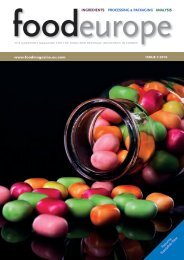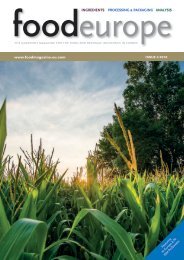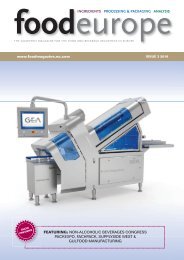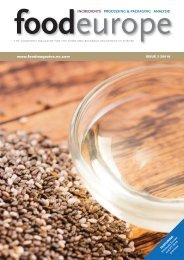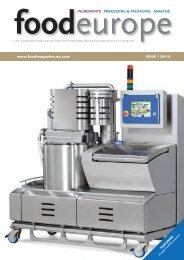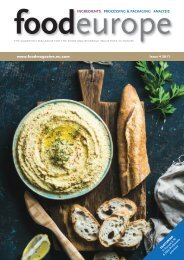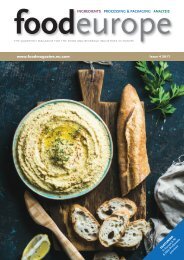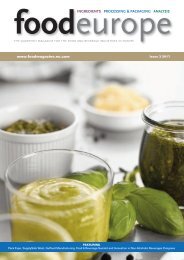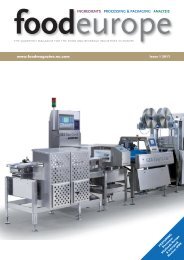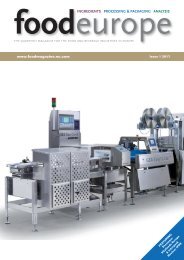FoodEurope Issue 4 2016
You also want an ePaper? Increase the reach of your titles
YUMPU automatically turns print PDFs into web optimized ePapers that Google loves.
56<br />
analysis & control<br />
Mineral oil residues in food<br />
Potentially harmful to health, components from mineral oil hydrocarbons (MOSH/MOAH) present<br />
in the inks and adhesives used in food packaging may migrate, exposing consumers to risk. Constance<br />
Voigt of SGS Institut Fresenius discusses this topical issue for food manufacturers.<br />
Harmful substances, including<br />
mineral oil hydrocarbons, can find<br />
their way into food through direct<br />
or indirect contact. The risk of<br />
contamination rises or falls<br />
depending on the food, pollutant<br />
concentration, and on the type,<br />
intensity and duration of contact,<br />
as well as on storage<br />
temperatures.<br />
Mineral oil hydrocarbon<br />
contamination comes in two forms:<br />
n Mineral Oil Saturated<br />
Hydrocarbons (MOSH)<br />
n Mineral Oil Aromatic<br />
Hydrocarbons (MOAH).<br />
MOSH/MOAH sources<br />
Cardboard packaging, a food<br />
industry favourite, is used across a<br />
wide variety of products, for<br />
numerous purposes. For example,<br />
to protect and transport dry,<br />
durable products such as pasta,<br />
rice, semolina, baking mixtures,<br />
high-fat products and<br />
confectionery. But cardboard is not<br />
the only potential source of<br />
MOSH/MOAH contamination.<br />
Paperboard and corrugated<br />
cardboard or recycled paper and<br />
newsprint are widespread and may<br />
be potential entry sources for<br />
contamination in food. In addition,<br />
manufacturing processes may<br />
provide others, for example,<br />
mineral oil is frequently used as a<br />
lubricant or release agent during<br />
food and food packaging<br />
production. Looking back further<br />
along the supply chain, it is also<br />
possible for MOSH/MOAH<br />
substances to enter a foodstuff<br />
during production. During<br />
harvesting or transport, for<br />
instance.<br />
No limits<br />
MOSH/MOAH contamination was<br />
identified and rose to prominence<br />
in 2010, when it was recognised by<br />
food authorities in . Since then,<br />
regulatory authorities, the food<br />
industry and food laboratories<br />
have worked together to identify<br />
the issues, sources and strategies<br />
to minimise contamination risks.<br />
Despite this work, there is<br />
currently no EU-wide regulatory<br />
framework nor are there binding<br />
tolerance values for<br />
MOSH/MOAH contaminants in<br />
food.<br />
However, in Germany, the Federal<br />
Institute for Risk Assessment<br />
(Bundesinstitut für<br />
Risikobewertung, BfR) has<br />
used its research and expertise<br />
to recommend three reference<br />
values, to help the food<br />
industry reduce risk. These<br />
are:<br />
n 12mg/kg for MOSH with<br />
carbon chain lengths of C10 to<br />
C16<br />
n 4mg/kg for MOSH with a<br />
chain length of C17 to C20<br />
carbon atoms<br />
n No maximum permitted level<br />
has so far been recommended<br />
for MOSH with a carbon chain<br />
length of C20 to C35.<br />
The toxicology of individual<br />
compounds is evaluated differently<br />
among the MOAH but it is not<br />
currently possible to analyse<br />
compounds and determine which<br />
are high-risk and which are riskfree.<br />
Hence, the difficulty in<br />
setting maximum levels for mineral<br />
oil residues in food.<br />
Minimising transfer risk<br />
Since 2010, products<br />
contaminated with MOSH/MOAH<br />
have come under increasing<br />
scrutiny. In 2012, the German<br />
consumer organisation, Stiftung<br />
Warentest, first referred to<br />
MOSH/MOAH residue in<br />
children’s chocolate advent<br />
calendars over the Christmas<br />
period in 2012. Since then, other<br />
German non-governmental<br />
organisations (NGOs) have<br />
www.foodmagazine.eu.com issue four | <strong>2016</strong>




